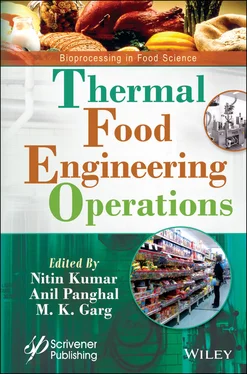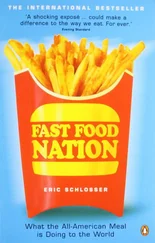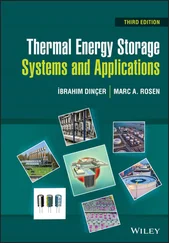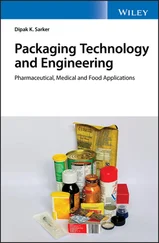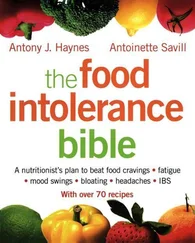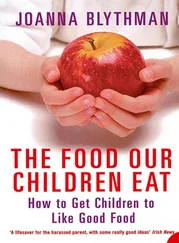NITIN KUMAR - Thermal Food Engineering Operations
Здесь есть возможность читать онлайн «NITIN KUMAR - Thermal Food Engineering Operations» — ознакомительный отрывок электронной книги совершенно бесплатно, а после прочтения отрывка купить полную версию. В некоторых случаях можно слушать аудио, скачать через торрент в формате fb2 и присутствует краткое содержание. Жанр: unrecognised, на английском языке. Описание произведения, (предисловие) а так же отзывы посетителей доступны на портале библиотеки ЛибКат.
- Название:Thermal Food Engineering Operations
- Автор:
- Жанр:
- Год:неизвестен
- ISBN:нет данных
- Рейтинг книги:5 / 5. Голосов: 1
-
Избранное:Добавить в избранное
- Отзывы:
-
Ваша оценка:
- 100
- 1
- 2
- 3
- 4
- 5
Thermal Food Engineering Operations: краткое содержание, описание и аннотация
Предлагаем к чтению аннотацию, описание, краткое содержание или предисловие (зависит от того, что написал сам автор книги «Thermal Food Engineering Operations»). Если вы не нашли необходимую информацию о книге — напишите в комментариях, мы постараемся отыскать её.
Presenting cutting-edge information on new and emerging food engineering processes,
, the first volume in the new series, “Bioprocessing in Food Science,” is an essential reference on the modeling, quality, safety, and technologies associated with food processing operations today.
This outstanding new volume:
Audience:
Thermal Food Engineering Operations — читать онлайн ознакомительный отрывок
Ниже представлен текст книги, разбитый по страницам. Система сохранения места последней прочитанной страницы, позволяет с удобством читать онлайн бесплатно книгу «Thermal Food Engineering Operations», без необходимости каждый раз заново искать на чём Вы остановились. Поставьте закладку, и сможете в любой момент перейти на страницу, на которой закончили чтение.
Интервал:
Закладка:
Since the 1990s, OH is now utilized in developing countries and all over the world. Almost a hundred processing plants have been placed all over the world. The market is in the developing stage and evolving constantly. OH equipment is installed all over the world such as in Italy, France, Spain, Greece, and Mexico [54]. The application of OH is not much commercialized for solid food products. For liquids, viscous liquids, and pumpable multiphase products, the installed set-ups perform the sterilization and pasteurization of numerous food products with great characteristics with main applications in vegetables and fruit areas.
Overall, the major issue involved in commercialization of electromagnetic techniques for numerous food applications is the lack of heat uniformity, which has a major impact on key variables of food processing and safety. To avoid this downside, hybrid systems are proposed, i.e., the combination of traditional and volumetric heating [54, 63]. The hybrid system offers advantages such as safety, improved process efficiency, and product properties. Successful hybrid techniques are IR-convective drying, a combination of IRH, IR-heat pump drying, and microwave heating, and many others are still in progress because of the magnified energy throughput.
1.2.1 Environmental Impact of Novel Thermal Technologies
The emergence of novel thermal technologies and non-thermal processes in food processing industries is capable of producing high-quality and standardized products. Both of them are environmentally sound and efficient in nature as compared to conventional technologies. Here we will consider more on the environmental footprints of novel thermal technologies. The primary objective in the food industry is food safety which requires high energy consumption, but novel thermal technologies are successfully able to balance energy saving and energy consumption.
The high value of hygiene and safety of food requires large use of water in both hot and cold cycles in production which consequently increases the environmental footprint. Processes such as cooking, sterilization, drying, and pasteurization require various types of energy. Novel thermal technologies are promising, attractive, and efficient in nature. They are capable of providing improved quality and reduced environmental effects which will eventually reduce environmental footprints. Novel thermal technologies can reduce processing costs followed by improving and maintaining the value-added products. Overall the primary types of energy used based on conventional thermal processing techniques are fossil fuel and electricity, majorly utilized in refrigeration and mechanical power in pumps. A heat exchanger is commonly used in the pasteurization of beverages where the pathogens are killed when heated to a particular residence time. During thermal treatment, convection and conduction play a major role to transfer heat to the products. For viscous fluids, directing heating process is applied, e.g., steam injection and steam infusion are utilized for thermal treatments. In the food and beverages industry, regarding the distribution of energy in 2002, Denmark suggests that total consumption of energy (TJ/Year) is 135,200 including the amount of heating and power. Adapted from [58].
This concludes that major heat is used in frying, evaporation, drying, and heating for thermal processes. Until the present moment, this trend is still functioning. Novel thermal technologies such as radio frequency, ohmic heating, microwave, etc., for food processing being continuously evolving. These novel thermal technologies have reduced emissions, reliability, improved productivity, high product quality, energy saving, water saving and consequently have less impact on the environment; [45] investigated that for Orange juice and cookies manufacturing, radio frequency drying (RF) can range up to 0 to 73.8 TJ per year in terms of primary energy saving. The major kinds of gas emissions from food industries are linked to power and heat production particulate matter and gases such as SO 2, CO 2, NO, from combustion processes. The particulate matter and volatile organic compounds (VOCs) and other chemical emissions are from methods such as size reduction, heating, refrigeration system, and cooking methods.
Conventionally 33% of the overall energy consumed in food processing corresponds to the production of steam. The steam is commonly used in drying, concentrating liquids, cooking, sterilizing, etc., in the processing of food processes. The generation of steam used in food industries involves the utilization of boilers. To remove the dissolved solid from the boiler system a large quantity of water is periodically drained from the bottom, which is called a blow-down. Inadequate blow-down may lead to the gathering of dirt which reduces the heat transfer rates and increases the loss of energy. Irregular boiler maintenance can decrease the efficiency of the boiler up to 20-30%. The efficiency of a boiler is affected by losses of heat by convection and radiation [58]. Improper boiler maintenance can also emit large emissions of CO 2and loss of energy. [58] also mentions the losses that occurred of a boiler or steam generation system composed of: gases from the combustion of air, or incomplete combustion, radiation losses, boiler blow-down water, heat convection, and fouling of heat transfer surfaces from hot boiler surface. Many attempts have been made to evolve a sustainable sector for lowering the emission of gases, e.g., CO 2and enhance the energy efficiency of devices and methods using renewable energy is now the main concern for every method. Therefore, using electricity in food powering systems may show an environmental benefit as compared to conventional techniques used. Overall novel technologies are considered sustainable, once they reduce the consumption of boilers or steam generation systems and eventually decrease the waste-water, heat loss and increase energy-saving and water-saving as well. Furthermore, the electricity is produced by an eco-friendly source of renewable energy; after that these methods will efficiently contribute to decreasing the pollution, assisting them to protect the environment. [82] shows the balancing by ohmic heating decreased the extent of solid leaching irrespective of the dimensions of the product. It is concluded by [65], OH blanching offers benefit in aspects such as water-saving by maintaining the quality of the processed products. Novel thermal can efficiently accelerate the drying processes when related to traditionally heat pre-treated samples allowing exact control of the process temperature and eventually it can decrease costs of energy, reduce the gas consumption and lower combustion-related emissions [53].
So we can conclude that novel thermal technologies are one of the most novel techniques in food preservation processes. Novel thermal technologies are quite efficient in all aspects such as the efficiency of energy, saving of water, and reduced emissions. Most of the processes involved in novel thermal technologies are green and hence more environmentally friendly, having the least environmental impact as compared to conventional technologies.
1.2.2 The Objective of Thermal Processing
The major purpose of thermal processing is to maintain certain quality standards, to reduce enzymatic activities, reduce microbial activities to enhance its shelf life, increase digestibility, and maintain certain physical and chemical variations to ensure its characteristic and safety of food. The objective also includes adding values such as maintaining its texture, flavor, color, etc., and make varieties of new products; it should also be needed by the specific section of the population. Over the past several years, consumer demands have improved standard, convenient and varied food which required the modification and development in existing traditional process for the new food preservation technologies. For that, the new novel thermal technologies evolved. Novel thermal technologies are better not only in terms of their quality improvements of food and heating efficiency but also in other important aspects such as water-saving, energy-saving, and reduced emissions. Most of these technologies are green and have less environmental impact and improve the added value of foods.
Читать дальшеИнтервал:
Закладка:
Похожие книги на «Thermal Food Engineering Operations»
Представляем Вашему вниманию похожие книги на «Thermal Food Engineering Operations» списком для выбора. Мы отобрали схожую по названию и смыслу литературу в надежде предоставить читателям больше вариантов отыскать новые, интересные, ещё непрочитанные произведения.
Обсуждение, отзывы о книге «Thermal Food Engineering Operations» и просто собственные мнения читателей. Оставьте ваши комментарии, напишите, что Вы думаете о произведении, его смысле или главных героях. Укажите что конкретно понравилось, а что нет, и почему Вы так считаете.
